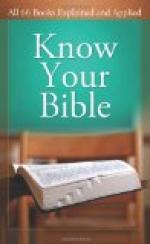2. The Noahic Covenant, Gen. 8:20-9:27. Outline the elements of the covenant, and the results affected.
3. The Abrahamic Covenant. Gen. 12:1-3; Acts 7:3. other details, Gen. 13:14-17; 15:1-18; 17:1-8. Outline, giving the elements, blessings proposed, temporal and spiritual or eternal. This is sometimes called several covenants but it seems best to consider it one that is enlarged upon from time to time.
4. The Mosaic Covenant, Ex. 19-30. Given in two parts: (1) Law of Duty (10 commandments), (2) Law of Mercy, Priesthood and Sacrifices Lev. 4:27:31; Heb. 9:1-7. (3) To whom given, Ex. 19:3 and to all, Rom. 2,12; 3:19, etc. (4) Its purpose: (a) Negative, Rom. 3:19-20, Gal. 2:16-21. etc; (b) Positive, Rom. 3:19, 7:7-13. (5) Christ’s relation to the Mosaic Covenant: (a) was under it, Gal. 4;4; Matt. 3:13, etc; (b) Kept it, Jno. 8:46; 15:10; (c) Bore its curse for sinners, Gal. 3:10-13; 4:45; 2 Cor. 5:21, etc; (d) Took the place of and ended the Priesthood and sacrifices, Heb. 9:11-15; 10:1-12, etc; (e) New covenant provided for believers in Christ, Rom.8:1; Gal. 3:13-17.
5. The Deuteronomic Covenant, Deut. 30:1-9. Outline its elements, giving things promised and prophesied.
6. The Davidic Covenant, 2 Sam. 7:5-19. (1) Elements of the covenant and summary in the Old Testament. (2) In the New Testament.
7. The New Covenant. (1) Formed, Heb. 8:6-13. (2) In prophecy. Jer. 31:31-34. (3) It is founded on the sacrifice of Christ. Matt. 26: 27-28; 1 Cor. 11:25; Heb. 9:11-12. (4) It is primarily for Israel, but Christians are partakers, Heb. 10:11-22; Eph. 2:11-20. (5) Jews are yet to be brought into it, Ezek. 20:34-37; Jer. 23:5-6; Rom. 11:25-27.
Note. Try to see how all of these covenants met in Christ.
* * * * *
Chapter 5.
The Division of the Scriptures.
In language and contents, the Bible is divided into two main divisions.
1. The Old Testament, 39 Books. 2. The New Testament, 27 Books. Total. 66 Books.
The Jews were accustomed to divide the Old Testament into three main parts, as follows:
1. The Law-the first five books, Genesis to Deuteronomy, otherwise called the Pentateuch and books of Moses.
2. The Prophets. These are divided into the “former prophets” or historical books and the “later prophets,” or books, which we commonly call the prophetic books.
3. The Writings, which was made to include; (1) Poetical books-Psalms, Proverbs and Job; (2) Five Rolls-Song of Solomon, Ruth, Esther, Lamentations and Ecclesiastes; (3) Other Books: Daniel, Ezra, Nehemiah and I and II Chronicles.
The Bible itself divides the Old Testament into the three following divisions:
1. The Law, which includes the first five books of the Bible, also called the books of Moses.
2. The Prophets, which includes the next twelve books, commonly called historical books and the seventeen books we know as the prophetic books.




